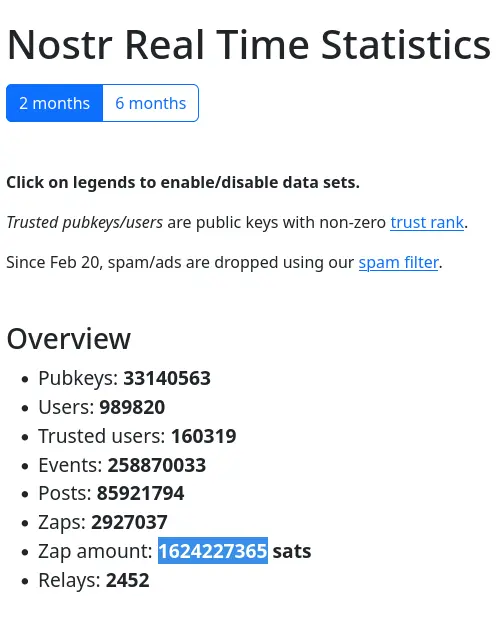Hi, my post is focusing specifically on YouTube since I observed the following categories have less intrusive solutions or privacy focused solutions, even if they are paid:
- Operating Systems (Linux, for example)
- Instant Messaging (Element, for example)
- Community Messaging (Revolt, for example)
- E-Mail (Proton, for example)
- Office (libreoffice, for example)
- Password Managers (Bitwarden, for example)
However, how do we distribute videos and watch them without data collection? I am NOT asking how do I use a privacy-focused front-end for YouTube, by the way, I am aware they exist.
I am wondering how we obtain a FOSS solution to something super critical such as YouTube. It is critical since it contains a lot of educational content (I’d wager more than any other platform), and arguably the most informative platform, despite having to filter through a lot of trash. During COVID, we even saw lecturers from universities upload their content on YouTube and telling students to watch those lectures. (I have first-hand experience with this at a respectable university).
I refuse to accept that there is nothing we can do about it.
You get me $10B annually or so, and then we can start to talk. Your single-fiber line and homelab will handle, what, 25 simultaneous users? Just have to scale that to a billion daily users or so, no bigger.
Also yt is “super critical”? Super critical is power for ICU wards and stuff, nobody is going to have a heart failure because they can’t get their daily dose of #shorts. Also gestures at Wikipedia, who is glaring at you.
I think you’re giving yt way, way too much credit, but simultaneously thinking that any one of us has the financial capability to not only have but risk that kind of cash. Companies have tried and failed. Users aren’t doing it, chief.
Everything seems critical when you haven’t tried living without. Meat eaters can’t comprehend living without meat. Car drivers can’t imagine living without cars.
I wondered how people pass their time without phones. Then my autistic son started demanding holding onto my phone for every waking minute he is not at school. Now I spend my day without the phone. Now that YouTube has stopped working on NewPipe, I’ve stopped watching it…and it felt a bit uncomfortable to kiss my videos before bed, but now it’s not a big deal. None of these thongs are critical. There’s a near infinite world of choices available to us now. We just need to pick something else.
Well said. I have found challenging myself to limit or go without certain things has had a great impact on my happiness and contentment. Once you realise you can get on fine without one thing, it puts everything else into perspective. Similar to you, I switched phone last month and purposely didn’t import any of my YouTube subscriptions to see how I’d go if I just didn’t have that constant stream of interesting videos there demanding my time. I went from an hour or two of daily viewing to nothing very quickly and the only impact it had was to free up more time in my day. I used to check daily for new uploads from my favourite YouTubers and now it doesn’t even enter my mind, I couldn’t care less.
You get me $10B annually or so, and then we can start to talk. Your single-fiber line and homelab will handle, what, 25 simultaneous users? Just have to scale that to a billion daily users or so, no bigger.
p2p could do this
The key problem that needs to be solved is the monetization problem. Nostr has a potential solution though. Over the last two months alone, their users have “zapped” (tipped/donated) other users around 950K (nearly 1 mil!) USD worth via lightning and that number continues to grow. And it doesn’t just make it easy to pay content creators, but to also put a portion of your “zaps” towards the relay you use or development of the software if you want. If you have a nostr account, you can easily tie it to a lightning address to send/receive tips, nostr doesn’t take a fee. Relays can also portion out a bit of their zaps for the people who publish the most engaging content on their relay. The possibilities are quite extensive. And because it’s over lightning, zaps happen instantly and for pennies or less in fees. Though, you can use nostr without zaps at all.
For those unfamiliar with nostr, it’s a decentralized social media software much like ActivityPub/mastodon, the main use right now is as a twitter/instagram clone but there’s also a reddit-style section being built up as well. Video hosting itself could be done by relays or through a P2P system similar to IPFS. Moderation abilities from the perspective of the instance/relay are identical to activitypub/mastodon. But one bonus if that if your relay goes down, you don’t lose your identity, since your identity and relay are separate. And if you change apps or relays (you are typically connected to multiple relays), all your content moves with you seamlessly. And the payment/zap infrastructure is all decentralized, relays don’t ever custody or manage the payments. If you tip a content creator, it goes directly from you to them. The lightning network has basically limitless transaction capacity. If you have cash app, it supports lightning, so you can already send zaps (you will need different apps to receive zaps though because cash app doesn’t support the LNURL standard). Strike natively supports it. And because it’s lightning, it works in every country automatically.
Long-term, if I am a content creator, which “fedi”-type system is going to be attractive to me? One where users can send me tips and mircopayments or one where they can’t? This is why I think nostr is going to win out long-term over AP/Mastodon. Mastodon could add this kind of functionality but I don’t get the impression they’re open to it. People may not want to commit to yet another $5/month subscription to a YouTuber’s patreon or nebula or whatever, but they are happy to tip 1-10c after watching a video. So there’s a psychological beauty to micropayments as well. As some random person I have made like 7c on tips this month, but I’ve also given out plenty to other people.
Source about nostr fees: https://lemmy.ml/post/17824358

Unfortunately this financing requires a populace widely adopting cryptocurrency…making it a pipe dream for mainstream use.
Tips are generally a bad model as well, which creates an incentive for rapid and pandering work (like ad supported content).
Patreon had frankly built all of YouTube that is worth watching. I think a simple payment system using real banks can be integrated into smaller hosting services.
It’s all academic though, YouTube is unrivaled in ad revenue and helping you expand an audience.
25% of Americans own crypto, usage continues to grow year after year both domestically and internationally. Most people have a crypto-capable wallet on their phone (CashApp, Venmo, Paypal). It solves problems traditional financial systems can’t solve well. That’s a trend that has been happening for 15 years.
People want something (YouTube but not YouTube) but don’t want to learn new techniques and technology (crypto). Eventually you have to leave them behind.
I didn’t know about this Nostr, but I do believe you’re right with the content Creator coming for the money, it’s always the money.
I’m going to give it a go!
I’m not sure if you can replace YouTube. It’s too popular and has been a mainstay of the Internet for 19 years. We won’t be able to convince people to just up and leave YouTube.
Best case scenario is to lead by example and start sharing videos from PeerTube.
same issue with twitter. too much momentum, not enough enshitification yet
Twitter’s different IMO. It relies on the network effect, whereas YouTubers get paid.
were not talkin about the small number of creators. its all about the audience . though i see what youre sayin… chicken and egg kind of thing… its ok, google is making it hard on them
I haven’t ever seen anything useful on twitter except funny tweets from musk
Not only that, I am certain Google will put as much money as needed into it not to allow any competing platform.
YT is not profitable, but gives them data, power and control.
I am NOT asking how do I use a privacy-focused front-end for YouTube, by the way, I am aware they exist.
My bad needed more coffee
The prior verbiage threw me off.
how do we distribute videos and watch them without data collection?
So opinion answer to the latter. Opinion answer. Don’t ignore YouTube.
Steam didn’t ignore Win32 and ask 10k devs to port to Linux. They partnered up with CodeWeavers, WINE and others to create Proton and it made the former task largely unnecessary.
Expand federated video services to cache all videos they stream in case the original gets dunked on. And then at the same time grow the platform.
A subsection of FOSS hates wealth, but people need to be able to lift themselves out of poverty, there has to be a profit motive and that profit has to largely go to the content creators.
Without motives and incentives you can build the most beautiful codebase ever and it won’t take off.
Mass censorship is coming, so platforms that don’t censor and host in countries where this is legally protected will have the advantage of growing new mega sites.
Pray that Google enshittifies YouTube enough for any amount of creators to migrate to Peertube
The big problem is there are a lot of good creators who are only able to be good creators in large part because of the YouTube ad revenue they get. They would otherwise have to work normal jobs and not be able to devote the time or resources to their videos. I have little faith that enough viewers would actually pay enough money to offset the ad revenue that supports many creators. Without a way to realistically replace that financial stream there is a large chunk of YouTube that can’t migrate. Of course, that’s no loss with some of the content mills churning out crap to try and cash in on the revenue, but I’ve seen plenty of good stuff that I’m not sure would exist another way.
There are at least in-video sponsors, as well as things like Patreon.
Money. Lots and lots of it.
Hosting video on a significant scale is very expensive. Stupendously expensive.
Convincing people to join is also going to cost a lot of money. Consumers are on YT because creators are there, and they are already used to the platform. Creators are there because the consumers are there. And there is a robust infrastructure to make a living from content creation.
Financing is especially difficult for such a project, because companies are willing to pay way more for targeted ads. For which you need some data about your users. The more data you collect, the better the and targeting can be, the more companies are willing to pay.
Assuming there are enough users for companies to pay for advertising at all.Check out FreeTube to privately watch YouTube videos, and PeerTube for a complete replacement.
That is a temporary solution. OP is looking for a whole other service to replace YouTube.
I thought peertube attempts to be a complete replacement
Look at the strangler pattern in microswrvice architecture. Applying this to your scenario, set up a front end to YouTube, cache the results locally (probably host in a place that allows it). Also host videos from other platforms like peertube. Once you have a lot of users, slowly prioritize “free” videos over YT content.
It’s not likely to happen, but it’s the pattern that FB uses to present news. First they showed a link to the story and you’d click through, then they required more of the story, then when all were hooked, they demanded the whole story to be displayed, effectively stealing all the users and the ability to advertise.
People use YouTube because YouTube pays them. You want to get paid without a middleman; you have to use cryptocurrency. The Fediverse hates crypto, so the Fediverse will never have a YouTube replacement.
People use YouTube because that’s where you get biggest outreach. YouTube pay a little, but YouTubers mostly rely on secondary incomes like sponsors and Patreon. Both of these are viable on any other platform.
Podcasts have mainly been using this model for a long time.
What exactly would prevent people from paying in actual currencies? Crypto is in no way a requirement for a YT replacement whatsoever.
then the bank could stop processing your payments because they don’t like your content
What exactly would prevent people from paying in actual currencies? Crypto is in no way a requirement for a YT replacement whatsoever.
You want to get paid without a middleman
This is the part you missed. Imagine Lemmy but for videos instead of links. Users pay creators via some subscription or likes mechanism. Lemmy instance admins do not want to deal with:
- Custodying the funds and having to keep them safe
- Having to make connections to every major national banking system or payment processor
- Dealing with chargebacks, payment disputes, counterparty risks, KYC/AML/other onerous regulations etc. People are used to cards being “instant” but full settlement on the backend takes days to weeks depending on how you define “settlement”.
Doing these things is an absolute nightmare and takes a lot of human time. Human time costs lots of money. All this just to move money from viewers to content creators.
Bitcoin via lightning, for example, can do all of this for them without any of that mess. Payments can go P2P directly from viewers to creators. Payments can be settled instantly for <1% in fees, usually pennies.
There are many payment services that require pretty much nothing from the server/instance once implemented, and doesn’t cost anything for the instance (the fees are taken from the payer), specifically to address the issues you mention. It’s already a solved issue.
And what are the fees like on those services? Does their fee structure work for micropayments? And do they support every country out-of-the box or are there some they don’t support? How do they handle chargebacks and counter-party risk? What is their settlement time? Do they occasionally freeze accounts for seemingly nonsensical or political reasons? Since we’re on the privacy community, how is their privacy? Can you, for example, sign up as an instance admin and automatically have them forward payments to content creators, or would you need to custom-code that through an API and then register with a non-standard account because now you aren’t a regular user but an intermediary? Try being an “intermediary” on Paypal and your account will get shut down very quickly, because you aren’t allowed to do that. You’d have to custom negotiate a special deal with them and fill out a bunch more paperwork and probably pay higher fees and meet a bunch of other requirements like being incorporated and obtaining insurance and auditors and the list goes on and on.
Ask anybody in the adult industry how much trouble they have getting access to these services even though the business they are engaging in is perfectly legal. Not grey area legal, fully certified legal by the US Supreme Court and appellate courts up and down the system for decades.
Answer these questions and you start to see the appeal of not having a third-party custodian do all this. Bitcoin lightning can do all of this, instantly, for 10-1000x less fees and massively less complication. You can say you don’t like crypto, that’s fine, but it’s legitimately better at solving these kinds of problems which is why adoption has been growing for 15 straight years.
But it’s not objectively better, because you can’t fucking use it. It’s digital tokens that are literally unusable until exchanged for real currencies, which brings the need for exchanges in to the picture (see my edit above).
You don’t have to convert it to fiat if you don’t want to, plenty of people use Bitcoin as currency, that is the entire point. Users tipped each other nearly a million USD worth of it on nostr int he last two months ($950k). You can go to any major city and find place to buy/sell/spend it. Many places online accept it too, of course. The network effect is quite large. Bitcoin’s market cap is larger than sweden’s GDP. It moves trillions of dollars of value every year. Not people “hodling”, people using it to do funds transfer.
But if you want to, you can absolutely convert it, with a single click. Those middlemen typically take a lower cut since they’re doing conversion not sending/receiving/settlement which is a much risker and therefore expensive service. There is, for example, no counterparty risk if you convert somebody’s BTC to their native currency, but there is if you transfer that person’s money to another person or act as an intermediary. I use strike for this, strike’s conversion fee is less than 1%, in many apps or exchanges, conversion is literally free because the app wants to incentivize you to store money with them and because it’s just updating some row in a database.
Peertube exists. Use it.
now I will admit that peertube is lacking content, but when you make something put it there. When you want something search there first and check out youtube last. This rewards those who publish there with your eyeballs
Are there any good PT clients for Android?
I like GrayJay. It has a PeerTube plugin.
I think you can use web browsers with it
Grayjay and I believe Tubular has a thing for it.
Check out newpipe
Newpipe works
firefox works great. You don’t need an app for everything.
I wish people would start uploading their videos to Pornhub so I wouldn’t get embarrassed whenever someone sees the app on my phone.
/s…or am I?
I refuse to accept that there is nothing we can do about it.
I don’t think you quite understand just how stupendous the amount of data Google processes from YouTube alone is. There is basically no way for hobbyists to provide an equivalent service. Very few companies have those kinds of resources. If you want, you can of course try running a PeerTube instance, but you rather quickly run in to problems with scaling.
I find it almost miraculous YouTube exists to begin with. It is no accident Google has very few competitors on that front, and I don’t think YouTube is even profitable for them. Without Google’s deep pockets and interest in monopolizing the market, YouTube would have withered a long time ago.
Trust me, I want a solution too. But 500 hours of content are uploaded to YouTube every minute. All of that is processed, re-encoded, and saved with multiple bitrates. You can’t compete with that. YouTube might eventually keel over from Enshittification and its own impossibility, but replacing it with anything meaningful will be a challenge.
Because Google builds out their network as an ISP and doesn’t pay for the internet like the rest of us.
I’d have agreed but hundreds of
fmoviesand similar sites exist on the high seas that provide free streaming of millions of HD content (movies, web series, etc.) somehow. They use some third-party video host that is magically able to concurrently serve millions of people.Those sites just scrape from many different file hosting sites. They don’t pay for that storage themselves.
the infrastructure of the pirate streaming sites is impressive, but I bet that is still orders of magnitude easier than hosting youtube.
Maybe the solution to YouTube is something similar to BitTorrent. It would make more sense for the protocol to preload the first chunk and to use a codec that can start with a lower res image and then fill in the resolution in subsequent passes. And on the front end, something like Lemmy would work, where channels and posts can be federated.
Considering the number of people who have 1gps symmetric bandwidth today, such a system should be able to technically work.
But nobody’s designed it yet AFAIK.
Counter-point : every single one of the videos uploaded to youtube already lives on the creators hard drive, usually in a much larger format. All that’s needed is for them to create torrents for them.
I think the largest challenge though is maintaining the distribution and managing the associated upfront costs.
Existing large content producers could likely afford to handle this but new producers could struggle paying to seed their content.
Though I do think overall this is more achievable than people give it credit for:
- YT videos don’t need huge bandwidth for a sustained period; only for short bursts. Most views come in within a week.
- Content is probably localized to specific countries. Less need to replicate across the globe.
- Let the source prefer to seed the highest quality and other peers downsample and replicate as needed.
- Doesn’t need YT scale. Tons of YT “content” is spammers leeching essentially free hosting from YT. No one needs to seed their videos if they don’t want to.
- 1080p is still fine for YT videos. h265 is very efficient (though downsampling 265 isn’t great). Don’t need 4k for most videos.
[…] I don’t think YouTube is even profitable for them.
Correct. Even Google, one of the richest companies in the world, is struggling to afford the massive infrastructure required to run YouTube. That’s why they’ve been cracking down on ad-blocking software lately.
Also, this is likely why they’ve been pushing their new updated Chromium-based infrastructure for web browsers, which will prevent ad-blockers from working on websites. If you’re not using Firefox or Safari to browse the Internet by now, you should switch. They’re the only independent browsers not using the Chromium framework.
None of these big tech companies are profitable because they pay their execs insane amounts of bonuses
I’d even buy subscription if it was a family one without music bundled for a reasonable price. No such luck in my country.
Restaurants don’t take steaks off the menu because they aren’t are profitable as salads. One date wants a salad, the other wants steak, they make less profit on the steak plate, but the average of the two is profit enough.
It’s ridiculous to look at any one service of these behemoth monopolies as an island - They are one collective thought, EVERY SINGLE PIECE does not have to be to enshittified to generate the biggest possible profit.
While I do agree with you, I also see twitch, TikTok and Patreon presenting models that are quite competitive with YouTube.
From a privacy perspective, free junk content like TikTok, YouTube and twitch will always be hard coupled with targeted advertising.
But Patreon (and onlyfans for that matter) do offer a model that can work without ads.
In fact, if Patreon also introduced an ad-supported tier and allowed you to more broadly see other content aside from the direct person you sponsor, it could probably grow quite a lot.
-
Tiktok is a company comparable in scale to Google. 130Bn in revenue last year.
-
Patreon is nowhere near the scale of YouTube. But I also think it’s the only viable solution to privacy and supporting creators.
-
Honestly the biggest thing all of us is missing to take it down is financial capital.
To get the kind of capital you need to take down YouTube, you need investment money from the kind of investors who will force you to enshittify to afford paying them back.
The financial issue is the biggest one, when it comes to any and all of these.
There are two YouTubes. One is the “creator” YouTube, algorithms, numbers blah blah
The other is the actual content creator YouTube. These are the channels that people actually follow. If captain disillusion set up his own RSS feed for videos, and I had the method to subscribe to it, I’d no longer need YouTube
The argument that YouTube has the algorithm and recommendations etc is moot, that’s the same job that every network does, you could absolutely replace this
The video content would have to be self hosted probably. How it used to be. So we need all these tools to eat YouTube’s lunch
Ok so first let’s go over what YouTube provides: Storage, community tools, search algorithm, add sense, authority over copyright, front end.
Realistically you could probably cover the front end, search algorithm, and community tools with FOSS collaboration.
Everything else gets harder.
For storage, the VAST swaths of data, and forever growing nature of YouTube storage nearly guarantee its market dominance alone… if they can contain that infinitely growing monster forever. Its their greatest strength and can also be its Achilles heel. I would propose that video hosting would be covered by the creatives. This change creates a ripple effect that effect all the other challenges, but immediately raises the bar for entry, and with the exception of the highest earning creators, videos would have to be cycled out when their earning capability falls below cost to host. But! This has good sides, like the best videos would linger and bad videos would fall off increasing the quality of what remains. Creatives would have more control over their videos. You could also have a system that rotates videos between a cold storage and live videos, where cold storage would use a torrent like system vs the streaming of a live system, which would allow cheap storage of low earning videos to still have them available for those who could wait.
Copyright, so with the creatives holding the keys to the content, this new youtube would only facilitate the connection and front end, but would not regulate it. So copyright claims would have to be handled by the creatives. This is a sharp as hell double edged sword! You won’t be copyright trolled as successfully any more BUT your odds of ending up in court could be higher as there is no way to appease the record labels and what have you so readily. There would also not be a method to scan the videos to easily find other people who are stealing YOUR content either. And you would have to deal with the person stealing your content directly.
And ad sense. Without a unifying front to bargain with advertisers, it will be like the Wild West. Most advertisers don’t have assurances of enforced standards and will be very timid to employ this new system. They would all have to vett creatives separately, and it would work allot like Sponcers do now, but ultimately i think it would be a boon, but for a wile the money won’t be there.
So i put more thought into this… assuming this was how a youtube competitor turned out. The negatives would begin to force certain human behaviors to mitigate risk. You would see guilds/channels form. This covers the weakness of the Wild West. Groups can bargain with more leverage from sponcers and demand more money in exchange for more consistency, these guilds/channels can also hire a lawyer on retainer if large enough to handle litigious tasks, and advise its members though copyright dangers. If it when it goes to court they can handle hiring of additional representation. The guild/channel would have say as to who they admit to the group, so they can expel risky members. But like joining an HOA creatives will have to adhere to the channels rules. But without a monolith controlling everything, you could find a guild/channel that has terms you agree with. This would bring a lot of the status quo youtube brings, but with everyone’s goals more aligned
For the algorithm,i would recommend using a hash tag system (i know they are not called hash tags but I’m in a stream of consciousness here) give creators the freedom to label hashtags to their content. Though to avoid gaming them, the value of views/upvotes is divided equally amongst all the tags, so if you put #hollow_knight as your only tag, you get more weight on a smaller net. Or if you act like an Amazon reseller and dump every single hash tag on you video to throw the widest net, you get a more shallow weight in each tag. I would count views AND like for this. Likes would be weighted more due to needing engagement. I probably would recommend not having down votes weighted either way, but obviously shown. And subscribing just guarantees the viewer gets notified at the top of the page.
I would also like to see if we can’t have embed 2 videos on the same page. So let’s say react videos. What if the reactor can que and control another video from the viewer. If you ever did a watchtogether it’s like that, but the reactors manipulation of the video is recorded like a Doom demo so it’s light weight, accurate, and most importantly of all… both creators get full credit for the views. No need to sue over copyright, a like button will be available for both videos. A juggernaut of a creator finding and reacting to another video will IMMEDIATELY have beneficial effects for the smaller creator. Colabs, head to head streams can share a chat. Weird art house effects can be used, ARGs made. On and on.
I think you SEVERELY misunderstand the content on YouTube and the content that pays and people watch. The average YouTube watcher is quite brain-dead.
The most profitable YouTube channels are:
- shitty Mr beast style clickbait videos
- kid cartoons
- music
- corporations
https://en.m.wikipedia.org/wiki/List_of_most-subscribed_YouTube_channels
https://en.m.wikipedia.org/wiki/List_of_most-viewed_YouTube_channels
https://www.tubefilter.com/2024/02/02/top-100-most-viewed-youtube-channels-us-january-2024/
The likes of popular youtubers with good content like Tom Scott and GamersNexus do not even make the list at all.
Good channels like Stories to Old that aren’t big, but well produced probably won’t be able to make it at all with this setup unless they form a coalition with other small creators to pay for hosting costs and have someone with the expertise to manage it. That cost would severely cut into what they would be able to live off of.
The most likely scenario is the platform becomes a wasteland of clickbait and child-friendly clickbait because that is what gets the most watch time.
The biggest issue I’ve always heard people say when it comes to replacing a video hosting service like YouTube is needing storage space and bandwidth.
I feel like ipfs, the interplanetary file system, could be leveraged to do this but it would require a concerted effort to make a fast, stable, reliable, and federated YouTube replacement, and I imagine that we would need people to financially support it.
IPFS is not free storage. Someone has to “pin” your video, where it then takes up space on their hard drive.
I never said that it was free storage. I said that it could be a solution to the video storage issue
I mean, if a million people each offered 100 GB of storage, you could store an awful lot of video.






















